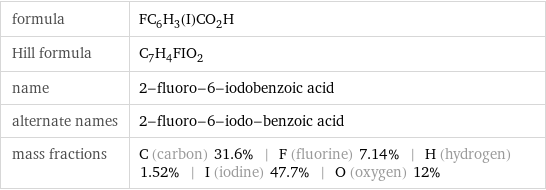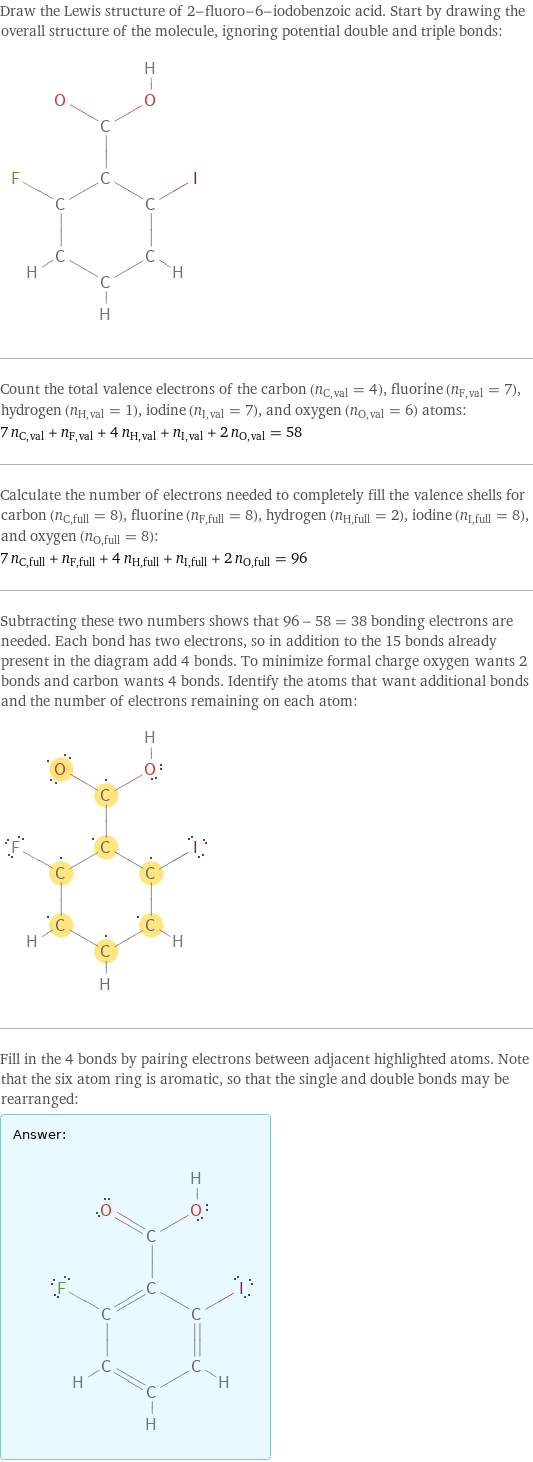Input interpretation

2-fluoro-6-iodobenzoic acid
Chemical names and formulas

formula | FC_6H_3(I)CO_2H Hill formula | C_7H_4FIO_2 name | 2-fluoro-6-iodobenzoic acid alternate names | 2-fluoro-6-iodo-benzoic acid mass fractions | C (carbon) 31.6% | F (fluorine) 7.14% | H (hydrogen) 1.52% | I (iodine) 47.7% | O (oxygen) 12%
Lewis structure

Draw the Lewis structure of 2-fluoro-6-iodobenzoic acid. Start by drawing the overall structure of the molecule, ignoring potential double and triple bonds: Count the total valence electrons of the carbon (n_C, val = 4), fluorine (n_F, val = 7), hydrogen (n_H, val = 1), iodine (n_I, val = 7), and oxygen (n_O, val = 6) atoms: 7 n_C, val + n_F, val + 4 n_H, val + n_I, val + 2 n_O, val = 58 Calculate the number of electrons needed to completely fill the valence shells for carbon (n_C, full = 8), fluorine (n_F, full = 8), hydrogen (n_H, full = 2), iodine (n_I, full = 8), and oxygen (n_O, full = 8): 7 n_C, full + n_F, full + 4 n_H, full + n_I, full + 2 n_O, full = 96 Subtracting these two numbers shows that 96 - 58 = 38 bonding electrons are needed. Each bond has two electrons, so in addition to the 15 bonds already present in the diagram add 4 bonds. To minimize formal charge oxygen wants 2 bonds and carbon wants 4 bonds. Identify the atoms that want additional bonds and the number of electrons remaining on each atom: Fill in the 4 bonds by pairing electrons between adjacent highlighted atoms. Note that the six atom ring is aromatic, so that the single and double bonds may be rearranged: Answer: | |
3D structure

3D structure
Basic properties

molar mass | 266.01 g/mol phase | solid (at STP) melting point | 124.5 °C
Units

Chemical identifiers

CAS number | 111771-08-5 PubChem CID number | 2733302 PubChem SID number | 24866900 SMILES identifier | C1=CC(=C(C(=C1)I)C(=O)O)F InChI identifier | InChI=1/C7H4FIO2/c8-4-2-1-3-5(9)6(4)7(10)11/h1-3H, (H, 10, 11)/f/h10H MDL number | MFCD00042289